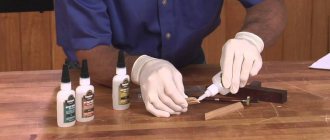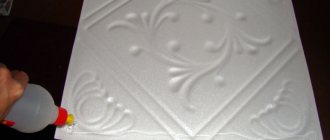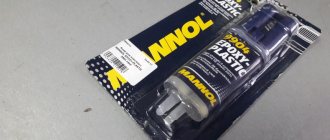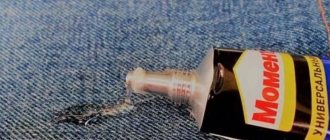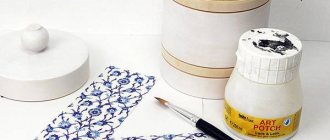Glass objects require repair more often than plastic and wood due to their fragility. When gluing decorative items, it is important to choose a composition that will be invisible at the seams. When it comes to fixing glass to metal or wood, then strength comes to the fore. This article will discuss the adhesive options available and their properties.
Properties of glass adhesive
Any glass is quite fragile and has a smooth, even surface. This can make gluing a challenge. That is why special adhesives were invented and produced that can hold glass elements together.
Each glass adhesive:
- Excellent adhesion of smooth and even surfaces to each other;
- Completely hardens in a fairly short period of time;
- Eco-friendly, does not contain toxic components;
- Resistant to moisture, waterproof, which is also important in the work process;
- Maximum elasticity;
- Quite thick;
- Ideally withstands any temperature changes.
Important: buy glue for joining glass parts only from familiar manufacturers. It may be more expensive, but the purchased material is guaranteed to properly glue the required surfaces.
Double-sided tape
This type of fastening has become very popular. It is suitable for gluing surfaces made of different materials. Double-sided tape has two main types:
- For horizontal fastening.
- For vertical fastening.
For those who don't really like working with glue, there is another way to glue wood and glass. This is, of course, high-quality double-sided tape ZM. This method works well if the glass is opaque. For example, you can mount a mirror on a wardrobe door this way. Operating procedure:
- Clean the glass or mirror from dirt.
- Wipe the wooden door from dust and remove unnecessary old material.
- Place tape on the glass surface and cut off the excess.
- Remove the protective tape and connect the glass to the wood.
- The connection must be made with precision, since the tape will prevent you from moving the glass if it is installed incorrectly.
Now you know another way to glue glass to wood.
Where is glass glue used?
Glass adhesives are quite limited in terms of use, since manufacturers do not recommend using them for working with other coatings.
As a rule, such adhesives help when necessary:
- Temporarily repair a broken window;
- Bring a porcelain or crystal product back to life;
- Repair the dishes;
- Repair an electrical appliance;
- Glue the mosaic pieces together;
- Glue beads or similar elements;
- Glue the side mirror in the car;
- Repair an aquarium, vase, etc.
The adhesive composition is always transparent, so the repair of a glass object always takes place without a trace.
Important: not every glass glue is suitable for repairing dishes and other products in which food is stored or from where it is consumed. In order to avoid poisoning and harm your own or someone else’s health, it is worth checking whether the composition is suitable for use for such purposes.
Useful tips
The adhesive must be suitable for the type of glass that will be glued, so before purchasing, you should read the manufacturer's recommendations on the product label. If the gluing area is large, it is convenient to apply the composition with a brush, so it is first poured into a suitable container. While working, you must protect your eyes by wearing goggles. If the glue contains a solvent, then the room should be ventilated by opening a window or vent. Difficult stains are removed from the glass with a metal kitchen brush.
Types of glass glue
Glass adhesive compositions are made in different ways and differ in their components. There are several types of this material:
Polymer
This transparent composition is created from polymer substances. Its peculiarity is that it dries exclusively under the influence of ultraviolet rays.
Polymer adhesives are usually needed for bonding mirrors, glass, solar panels, jewelry and the like. To use this material, you will have to acquire an ultraviolet lamp.
Pros:
- Resistant to sudden and severe temperature changes;
- Does not lose its properties when exposed to moisture;
- Withstands a variety of mechanical loads well;
- The adhesive seam is completely transparent and completely invisible;
- Fire resistant, does not contain toxic components.
Important: some types of polymer glass adhesives must be applied in two layers (everything is always described in detail in the instructions). Before gluing parts, you must carefully study the manufacturer's recommendations on the packaging.
Cyanoacrylate
This variety is not particularly often used in work. Such adhesive compositions are usually required for high-quality connections of elements, since they will subsequently be subject to increased loads.
Pros:
- Dries quickly after applying a seam;
- Incredibly resistant, capable of gluing elements for a record long time;
- Can be used on painted glass.
Cyanoacrylate glue is excellent for those cases where glass parts need to be bonded to each other very quickly but effectively. This variety is used in gluing optical parts, microcircuits, conductors and other similar objects.
You cannot purchase such a composition in every store - there are specialized ones for this.
Silicate
This adhesive composition is very similar to liquid nails used in construction and industry. It is made from sealants or silicone substances.
Pros:
- It has a huge selection of shades, so it’s easy to choose the right adhesive for colored glass (which is why it is often used in design and interior decoration);
- The adhesive seam is highly durable and very reliable;
- The cost of the material is low, so almost everyone can afford it.
Silicate glass adhesives are waterproof, waterproof and capable of bonding elements even in very wet rooms or areas. In addition, it is worth noting that these adhesive compositions can withstand elevated temperatures, and besides, they themselves are heat insulators.
Various biological pests such as insects, mold or fungus will not appear and multiply in the future on the resulting adhesive joints. Due to this, silicate glue is often used for work related to country house construction.
Important: when working with silicate compounds, you should be as careful as possible, since they have a fairly strong alkaline reaction. The glue should not come into contact with exposed skin and mucous membranes. It is recommended to carry out work wearing gloves and a respirator.
Domestic
For a simple repair of a glass object at home, you can use any household glue. In this case, PVA for glass will be the best. This material costs little and is good for minor repairs to an object that is usually not subject to stress.
Household compositions are safe and cannot harm a person even if they come into contact with the skin. Just wash the stained area with water or wipe with a towel.
How to glue
It turns out that this is only at first glance gluing - a process without much intricacy. In fact, it is important to know exactly what to do and how to do it, otherwise the result will disappoint you.
The subtleties of the glass gluing process depend on what material the parts are made of.
First of all, before starting work, prepare the parts that you will glue, latex gloves and adhesive. Cover the table (floor or cabinet) on which the work will be done with film, then it will be easier to remove drops of glue. Wash the surface of the parts to be glued with soapy water or degrease with alcohol. If you are gluing broken pieces together, be careful not to cut yourself on the sharp edges.
The surfaces of the parts must be washed in water and soapy water or degreased with alcohol.
After drying, apply glue to one of the parts and press the second one tightly to it. If you use a cyanoacrylate compound, the pressing time is a few seconds. If the glue is silicone, it will take a few minutes.
If you use UV glue, then after the above steps you will need to heat the parts to 40 degrees. You can use a hairdryer for this. It is important to position the part in such a way that the glue does not drain from it, firmly fix the surfaces to be glued, and then place it under a UV lamp for 30 seconds. If you don't have a special lamp, leave the combined parts in sunlight. Of course, in this case it will take more time, but the quality of gluing will be decent. If excess glue appears at the edges, they are cut off with a knife or removed with a special scraper, but only after it has hardened.
The exposed glue is removed with a scraper or cut off with a knife after hardening.
When gluing glass and metal, the main thing is to choose the right composition. Either UV glue or another adhesive composition will do, but always with a gel-like consistency. Then the glue will not spread around the edges. Surfaces are degreased and heated to +40 degrees. The seam is positioned horizontally and glue is applied to it. After this, the parts are pressed tightly and fixed using special clamps.
If there is no lamp, the parts can be placed on a window under the sun's rays; it will take more time to polymerize, but the result will be the same.
Heat Resistant Glass Adhesive
As the name suggests, this glue is used for joining and repairing objects that are usually exposed to high temperatures.
For example, this composition is suitable for working with the following elements:
- Glass tiles;
- Electric kettle body made of glass;
- Oven front, etc.
Among the components of heat-resistant adhesive compositions there are special additional components that help the frozen material not to deteriorate under the influence of heat and not lose its properties.
You need to choose glue depending on what kind of work you want to do. Now you have learned about the existing types of glass adhesives and where they are used. Guided by this information, you can easily determine what composition you need and purchase it in the store.
What to glue it with?
To glue two materials, such as glass and wood, many substances can be used. Most of the adhesive mixtures are professional, and they are used mainly in factories, construction sites, etc. Let's consider various gluing methods that are available to non-professionals. This will allow you to use them at home. Adhesives that can be purchased at hardware stores. Simple glue options:
- PVA.
- "Liquid Nails".
- Two-part Scotch-Weld adhesive.
- Double-sided tape ZM.
- Thermoactive glue.
You can also contact the seller and get advice, or read the instructions on the packages of glue of different brands.
Photo of the best glue for glass
Preparation for work and gluing nuances
When a gluing method has already been chosen, this does not mean that a positive result is guaranteed. High-quality training and competent work technology are of great importance.
- The necessary measurements are taken and the configuration of the elements that need to be connected is determined. During repairs, this will not be required, but when creating a new product, this must be done in advance so as not to be distracted once again.
- When, for example, you need to glue a mirror to a cabinet door, you must first make markings. This will ensure both reliable and attractive results.
- All surfaces should be thoroughly cleaned. Dirt and old glue must be removed, otherwise they will interfere with normal adhesion and reduce the adhesion of the glue.
After reading the article, you can understand what kind of glue should be used for gluing glass and wood, as well as how to properly organize the work process. Perhaps one of the readers knows other options for gluing such elements. Share your secret in the comments, it will probably be useful to other people.
Did you like the article? Subscribe to us in Yandex Zen. By subscribing, you will be aware of all the most interesting news. Go and subscribe.
How to glue wood to glass? This question interests everyone who comes into contact with repair and design. The fact is that materials that are so different in structure require a special approach. What are the ways to connect them and what are the advantages of each of them, read here.
DIY cooking: instructions
Even despite the budget cost, some housewives prefer to prepare the glue themselves. However, to do this, you must have certain components on hand. It is better to cook it in large quantities at once. To create, you will need potassium silicate, sodium silicate and silicic acid. Step-by-step instruction:
- Connect two silicates together. They must be taken in equal proportions.
- Add 10% acid solution. You can also dilute the substance to a certain strength manually.
- Add acid to form liquid on the surface of the mass.
- Put the mixture on fire. Set the heat to low and cook for 10 minutes. Stir constantly.
- Cool the mixture and pour into containers that are sealed tightly.
Technical specifications
According to GOST, the technical characteristics of silicate glue include:
- the substance has a thick consistency of yellow or greenish tone;
- absence of visible impurities;
- density indicators - 1.36-1.45 g per 1 cm3;
- amount of insoluble substances – 0.2%;
- Shelf life in original packaging – 24 months;
- Freezing and defrosting is acceptable;
- the use of an adhesive-based insulating layer is carried out at a temperature of +1300°C.
Compound
The concept of “silicate glue” includes the name of substances with approximately the same qualities, but different compositions. Let's look at what silicate glue is in general.
The glue looks like a transparent, greenish or brownish gel, the obligatory substance in which is silicic acid salts.
Additionally, the composition includes oxides of alkali metals - either sodium, or potassium, or lithium. Therefore, there are three main types of glue: sodium, potassium and lithium. Each of them creates an adhesive mass that has similar, but inherent properties to each individually.
At home, at school and in the office, the name for this mass is stationery or office glue. In industry - silicate glue liquid glass.
The adhesive properties of liquid glass are directly proportional to the silicate module - the ratio of the amount of silicon raw materials to the amount of the alkaline component. The range of values of the silicate module is 2.0 – 4.0.
The chemical formula of liquid glass is Na2O+SiO2.
Production methods
Silicate glue is produced by several technological methods. You can fuse quartz sand with sodium bicarbonate (baking soda) in a special vessel. The product can also be obtained by treating silicate with solutions of sodium hydroxide (NaOH), potassium hydroxide (KOH) and/or lithium hydroxide (LiOH).
The resulting substance has high adhesion to almost any surface. The adhesion of dissimilar planes (adhesion) is based on the physical properties of solids. The application of silicate glue stimulates the emergence of attraction between molecules that are weaker connected at the surface than inside. Due to the adsorption of the adhesive liquid, the viscosity increases and the adhesive seam becomes denser. Due to a shift in the equilibrium of surface particles and modification of silicic acid chains, a polycondensation process occurs and a reliable adhesive seam is formed.

